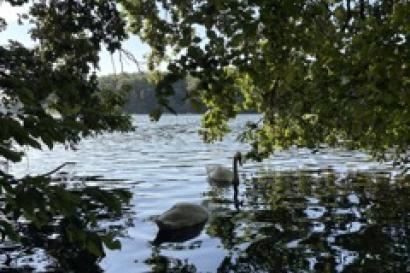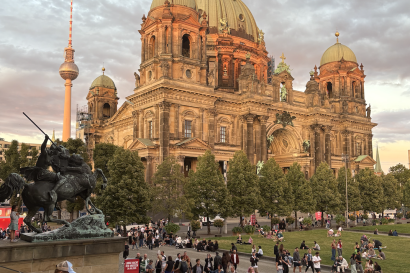
A map of Tiergarten (for a comparison to the rest of Berlin visit: https://goo.gl/maps/ukN6I)
I’ll be honest, this post originally started with a class assignment. The class: History of Modern Berlin, the assignment: research your favorite place in Berlin, and write a small essay about its history and why it is important to you (in German of course).
I had a lot to think about. I’ve been in Berlin for 2 ½ months now and know that this city can’t possibly be defined by one specific place, and the more I thought about it, the more I realized how many different places I enjoy (or would call my favorite). Eventually, my thoughts kept returning to second biggest park in Berlin (and third in all of Germany): Großer Tiergarten
.
Tiergarten is beautiful, huge, and has an important history throughout Berlin’s development as Germany’s capital. The park itself is 520 acres and is located on the Westside of Berlin (in between different sections of Berlin: Charlottenburg, Schöneberg, Mitte, and Kreuzberg).
So here’s a little history:
The park has always been as big as it is now, but if you were to find yourself inside it in the late 1600s, you would find no fences, pathways, or streets. Friedrich I decided (during his reign of Prussia in the early 1700s) that the park was to be closed and to be used only by members of the royal family and those of nobility. He had the park fenced off and only ‘certain’ persons were allowed in. The nobles used Tiergarten primarily for sport-hunting (which is where the name Tiergarten comes from- tier meaning animal), but during the reign of Friedrich the Great, Tiergarten changed completely.
Friedrich the Great imagined a park that was completely open to the public. This idea (coupled with the fact that he was not a big fan of hunting) pushed Friedrich the Great to open Tiergarten to the people of Berlin in 1740. Although still owned by the royal family, Tiergarten was no longer fenced off and the people of Berlin were free to visit it whenever they chose.

Actual construction, or shaping, of the garden/park began in 1814 and lasted until 1842. This shaping was highly influenced by gardener Joseph Lenné, who focused on reconstructing the garden to look like the English Gardens. In 1888 Friedrich III gifted the park to the city of Berlin (making it the first time that Tiergarten was an actual ‘public’ park). The next years were filled with several changes as the city developed structurally and culturally. As Immigrants flocked to Berlin (because of the location and cheap prices- particularly after WWI) and the city expanded its roadways and infrastructure, Tiergarten remained the same beautifully big park where the people of Berlin could relax and enjoy a beautiful day.
The next huge developmental phase came during the time of the Nazis (1933-1945). Hitler had a plan not only for Berlin as the capital of the entire world, but also for Tiergarten as the center of this new world capital. Hitler had his chief architect, Albert Speer, reconstruct Tiergarten. New paths were added, others were enlarged greatly, and Speer added the Siegessäule (‘Victory Column’- a very famous monument in Berlin dedicated to Prussia’s victory over Denmark, Austria, and France) to the middle of Tiergarten with two main streets crossing at the intersection.
During this time Tiergarten saw a huge development that changed the park’s structure and appearance, but it didn’t stay that way for long.
The Second World War officially began in 1939 with Germany’s invasion of Poland and as the war drew to a close, Berlin (as the capital of Germany) was highly targeted for destruction (mainly by bombing). In total, 70% of Berlin was destroyed during WWII. This affected Tiergarten greatly and almost all paths, bridges, and statues were destroyed. After WWII Germany underwent a great reconstruction effort that included Tiergarten. At first Tiergarten’s open areas were used as farm fields to produce food, but were later converted back to their original forms.

Eventually Tiergarten was fully reconstructed (paths, bridges and statues) and served as the main park of West-Berlin while the city was divided. Now as you walk through the park you can see several different statues (usually attributing to the animals that once used to live there), walk over bridges that go over several different rivers that flow through the garden, and see a lot of different people bathing in the sun, playing soccer, or sitting on a bench relaxing in the park.
Tiergarten is one of my favorite places in Berlin because of its beauty, location, and enormity. It is only a 8 minute bike ride away from my apartment in Schöneberg and I ride through it almost every single day because it is on the way to where my classes are. Sometimes I’m in a hurry and ride through the park on a mission to get somewhere on time, but, normally, I take my time going through Tiergarten. I’ll take new paths, explore, and find myself in a different place I haven’t been to before, even after all how long I’ve been here! If you’re in Berlin for a visit, or an extended stay, I highly recommend going to Tiergarten. Find a day where the sun is shining, bring a nice book or soccer ball, and relax with the rest of the Berliners in a park that has been an important part of Berlin history since the late 1600s.
Evan Weyrauch
<p><span style="color: rgb(29, 29, 29); font-family: Arial, Verdana, sans-serif; font-size: 12px; line-height: normal; background-color: rgb(237, 237, 237);">My name is Evan, I am a student at Carthage College in Kenosha, WI, and am currently a foreign exchange student studying in Berlin, Germany. I enjoy writing, reading, and photography. I meaningful experiences and I try my best to show that meaning through my work.</span></p>




